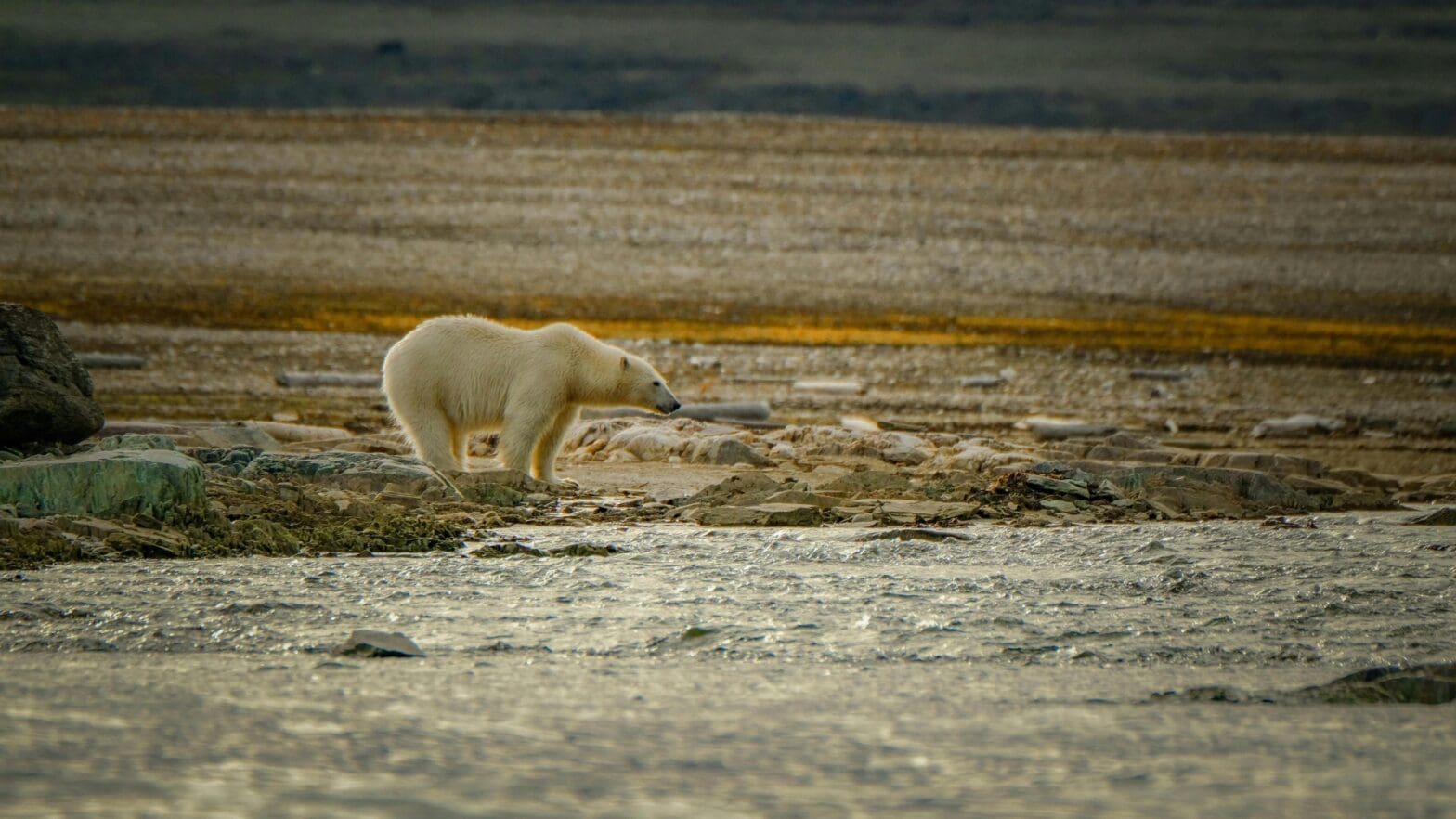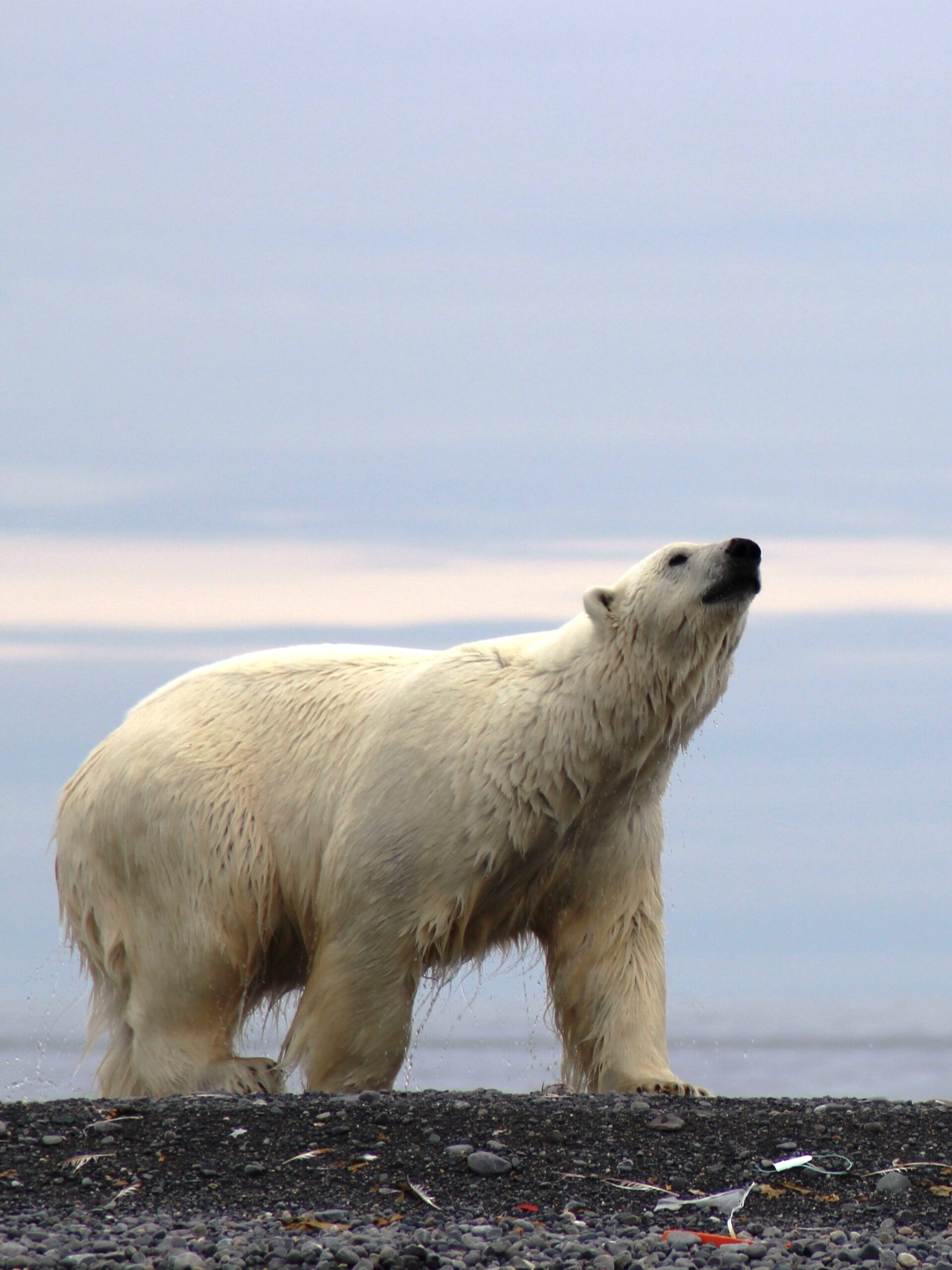
Polar Bear
The White King of the Arctic
Last update: 10. September 2025
Polar bears can be encountered in wide-ranging areas of the Arctic. Although most polar bears are born on land, they spend most of their lives on the sea ice.
Download PDF

Because of their dependence on the sea ice, polar bears are classified as marine mammals. The polar bear is listed as a vulnerable species by the International Union for Conservation of Nature but is still hunted in North America and Greenland (in the regions under Russian and Norwegian jurisdiction all hunting is banned).
As a species, polar bears have evolved many characteristics that make them especially adapted for cold temperatures, hunting seals and for moving fast across snow, ice and open water. Polar bears have a well-developed sense of smell and are excellent swimmers that can swim long distances. They are at the top of the marine food chain and feed almost exclusively on seals with a very few regional exceptions.
A bear can survive up to eight months without eating. Pregnant female polar bears dig a snow den in early winter, give birth to cubs usually weighing 500-600 grams in late December, and emerge with cubs weighing 8-10 kg three-to-four months later. During this
time, they live off their fat reserves. Males are larger than females, and can weigh 400-600 kg. Adult females typically weigh 150-250 kg depending on the season, geographic area and general condition.
Watching undisturbed wildlife in its natural environment is an unparalleled experience. To avoid disturbance when encountering polar bears, you are asked to be considerate and follow these wildlife guidelines.
Guidelines
- Always be vigilant for bears when in “bear country”.
- Always have a plan and be ready to act to avoid encounters by implementing safety measures beforehand.
- Do not lure, follow or seek out polar bears.
- Do not seek out polar bears in such a way as to disturb them or expose bears or humans to danger.
- Never feed or leave anything edible where it can be found by bears.
- Always keep your distance to ensure the polar bears are undisturbed and always maintain minimum distances where they are mandated, and at least 50 meters where none are defined.
- If a polar bear is in sight, observe the animal’s behaviour and be prepared to stop, retreat or act on short notice.
- Never approach polar bears closer than 200 meters with any vessel of more than 10 meters in length. In some parts of the Arctic, it is prohibited to approach a polar bear knowingly from any distance with a vessel of any size.
- Small vessels and vessels with low outside decks (vessels/ motherships) must never allow a bear to approach the broadside. In some parts of the Arctic, active measures should be employed to deter polar bears from approaching your vessel.
- Always maintain a safe and non-disturbance distance between the Zodiac and the land/ice/spot where a polar bear is present. Always adhere to local regulations and the prescribed minimum distances within. If none exist, always maintain at least 50 meters.
- If observing polar bears from Zodiacs/small boats, these vessels must always be positioned so that the area can be left in a safe and controlled manner should the situation require it.
- Never follow or approach a swimming polar bear, from any angle. If you catch sight of a swimming polar bear, retreat immediately to at least 200 meters, or to the minimum distance mandated under local regulations, whichever is greater. Swimming bears are at the most risk; afford them space and all rights of way.
- Do not seek to maintain this distance by following a swimming bear, even if moving in parallel – under no circumstances should any small boat or vessel follow a swimming bear, anywhere. The bears’ intentions are not always obvious, and all directions of travel must be freely available to the bear.
- Your position may need to be reevaluated – be prepared to depart the area entirely.
- If you are planning shore excursions, check out the terrain before landing the passengers.
- Do not make a landing if you cannot see clearly; for example, if you have low visibility due to fog.
- Do reconnaissance and look out for polar bears before any passenger comes ashore.
- Guides carrying firearms and other bear deterrents must lead the group.
- Establish a polar bear watch system and stay in places where you have good visibility of the surrounding area.
- Set up and maintain your chosen landing site effectively. Consider that you may need to depart in a hurry; cache your landing and shore equipment appropriately and manage resources allowing you to depart quickly. Be mindful of the beach profile and tides, especially if leaving boats unattended.
- If you find a dead polar bear, report it to local authorities in accordance with regulations and local requirements.
Beware and Take Care of the Polar Bear
The polar bear is the world’s largest predator and it is dangerous to humans. Above all you should avoid confrontations with bears. In areas with polar bears, encounters must be expected anywhere, anytime. Polar bears are best observed from a distance, when they are undisturbed.
Hurting or killing a polar bear is an offence if not done in selfdefense. Irresponsible actions leading to such a situation can
also be deemed an offence. As a rule of thumb, a polar bear’s behavior should not be altered because of your presence.

Firearm Handling
All guides and polar bear guards should be experienced in the safe handling of firearms, have good shooting skills, and have knowledge about polar bear behavior. Unless the user is familiar
with the firearm and has had sufficient training with a firearm, the sense of safety provided is deceptive.
Appropriate means of frightening and chasing off polar bears should be part of the equipment, such as flare guns and flare pens equipped with thunder flashes or signal cartridges, sirens and similar. Such equipment should be carried so that it is readily accessible.
Regulations
Local legislation supersede AECO Guidelines. Ensure familiarity with local law in each region.
Svalbard
It is a violation of Svalbard’s Environmental Protection Act’s general principle of protection to disturb polar bears. According to the Act “All species of flora and fauna, including their eggs, nests and lairs, are protected …” and “all access and passage in Svalbard shall take
place in a way that does not harm […] or in any other way […] result in unnecessary disturbance of animals.” (Section 25 and 73 of Act of 15 June 2001 No.79 Relating to the Protection of the Environment in Svalbard.)
In Section 30 of the Svalbard Environmental Protection Act it is stated that: “It is prohibited to lure, pursue or otherwise seek out polar bears in such a way as to disturb them or expose either bears or humans to danger.” (Act of 15 June 2001 No.79 Relating to the Protection of the Environment in Svalbard).
Amendments to the Act (announced 7th June 2024 and coming in to force 01st January 2025) additionally states in Section 30a that “it is prohibited to unnecessarily disturb, lure or pursue polar bears.
No one may travel or stay closer than 300 meters to a polar bear. From March 1 to June 30, no one may travel or stay closer than 500 meters to a polar bear. Anyone who spots a polar bear closer than the distance limit must move away so that the legal distance is maintained. The distance limit does not apply in inhabited areas, when staying in research stations, cabins, tents or similar facilities.”
Section 30 also lays down several general measures in respect to polar bears, among these are: “Any person travelling outside the settlements, with the exception of visitors and permanent residents who are taking part in organized tours, has a duty to familiarize
themselves with safety measures in respect of polar bears. Necessary measures shall be taken to avoid the danger of polar bear attacks and to ward off an attack without injuring or killing the animal.” (Act of 15 June 2001 No.79 Relating to the Protection of the Environment in Svalbard.)

Key Points and Considerations from the Amendment:
- A minimum distance of 300 metres must be maintained. From March 1st until June 30th a minimum distance of 500 metres must be maintained. Appropriate measures and means of determining and maintaining this distance must be employed.
- If a bear is spotted within these minimum distances, there is an obligation to move away immediately, or as soon as safe to do so.
- Any form of behavioural change in the polar bear, not only restricted to a bear leaving or fleeing an area, can mean your presence has unnecessarily disturbed the polar bear, no matter the distance.
- Attracting a polar bear should not be considered limited to traditional means of luring a bear; attracting can mean simply and deliberately remaining in situ and drawing curiosity and attention from a polar bear.
- Pursuing a polar bear can be interpreted as any action, means or method of following a polar bear. Always remain mindful of yourintentions.
- The prohibition on seeking out polar bears includes deliberately heading to an area where one has knowledge that a bear or bears have been stably present or attracted.
Greenland
According to the Government of Greenland Self Rule Act on Capture and Protection of Polar bears of March 6, 2023, section 4, it is prohibited to lure, pursue, seek out or in other ways disturb polar bears. If you spot a polar bear, you should retreat immediately.
Specific regulation applies for polar bear viewing organized by a Greenland resident with a Greenland Government issued permit. In other regions of the Arctic national and local regulations may include different provisions. Always check and abide by the legal requirements in the area you are visiting.

AECO’s Guidelines Are Funded by
